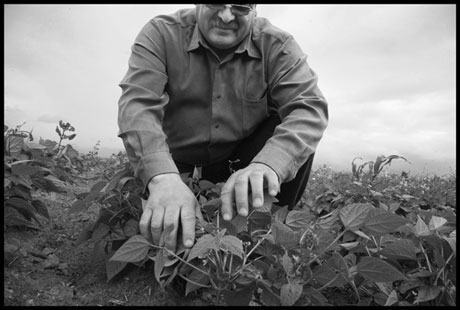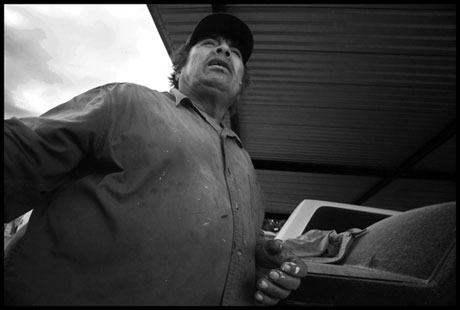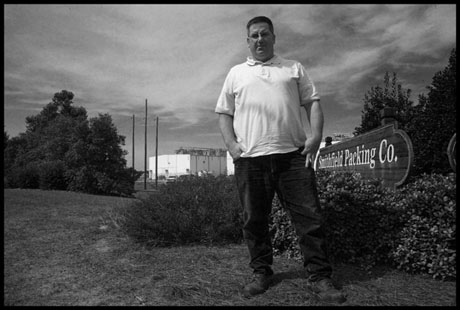
Roberto Ortega tried to make a living slaughtering pigs in Veracruz, Mexico. “In my town, Las Choapas, after I killed a pig, I would cut it up to sell the meat,” he recalls. But in the late 1990s, after the North American Free Trade Agreement (NAFTA) opened up Mexican markets to massive pork imports from US companies like Smithfield Foods, Ortega and other small-scale butchers in Mexico were devastated by the drop in prices.
“Whatever I could do to make money, I did,” Ortega explains. “But I could never make enough for us to survive.” In 1999 he came to the United States, where he again slaughtered pigs for a living. This time, though, he did it as a worker in the world’s largest pork slaughterhouse, in Tar Heel, North Carolina.
His new employer? Smithfield—the same company whose imports helped to drive small butchers like him out of business in Mexico.
David Ceja, another immigrant from Veracruz who wound up in Tar Heel, recalls, “Sometimes the price of a pig was enough to buy what we needed, but then it wasn’t. Farm prices were always going down. We couldn’t pay for electricity, so we’d just use candles. Everyone was hurting almost all the time.”
Ceja remembers that his family had ten cows, as well as pigs and chickens, when he was growing up. Even then, he still had to work, and they sometimes went hungry. “But we could give milk to people who came asking for it. There were people even worse off than us,” he recalls.
In 1999, when Ceja was 18, he left his family’s farm in Martinez de la Torre, in northern Veracruz. His parents sold four cows and two hectares of land, and came up with enough money to get him to the border. There he found a coyote who took him across for $1,200. “I didn’t really want to leave, but I felt I had to,” he remembers. “I was afraid, but our need was so great.”
He arrived in Texas, still owing for the passage. “I couldn’t find work for three months. I was desperate,” he says. He feared the consequences if he couldn’t pay, and took whatever work he could find until he finally reached North Carolina. There friends helped him get a real job at Smithfield’s Tar Heel packinghouse. “The boys I played with as a kid are all in the US,” he says. “I’d see many of them working in the plant.”
North Carolina became the number-one US destination for Veracruz’s displaced farmers. Many got jobs at Smithfield, and some, like Ortega and Ceja, helped lead the sixteen-year fight that finally brought in a union there. But they paid a high price. Asserting their rights also made them the targets of harsh immigration enforcement and a growing wave of hostility toward Mexicans in the American South.
The experience of Veracruz migrants reveals a close connection between US investment and trade deals in Mexico and the displacement and migration of its people. For nearly two decades, Smithfield has used NAFTA and the forces it unleashed to become the world’s largest packer and processor of hogs and pork. But the conditions in Veracruz that helped Smithfield make high profits plunged thousands of rural residents into poverty. Tens of thousands left Mexico, many eventually helping Smithfield’s bottom line once again by working for low wages on its US meatpacking lines. “The free trade agreement was the cause of our problems,” Ceja says.
Smithfield Goes to Mexico—and Migrants Come Here
In 1993 Carroll Foods, a giant hog-raising corporation, partnered with a Mexican agribusiness enterprise to set up a huge pig farm known as Granjas Carroll de Mexico (GCM) in Veracruz’s Perote Valley. Smithfield, which had a longtime partnership with Carroll Foods, bought the company out in 1999.

So many migrants from Veracruz have settled in North Carolina and the South that they name markets for their home state. Because of ferocious anti-immigrant laws, however, many businesses have lost customers as immigrants flee the state. (Photo: David Bacon)
By 2008 the Perote operation was sending close to a million pigs to slaughter every year—85 percent to Mexico City and the rest to surrounding Mexican states. Because of its location in the mountains above the city of Veracruz, Mexico’s largest port, the operation could easily receive imported corn for feed, which makes up two-thirds of the cost of raising hogs. NAFTA lifted the barriers on Smithfield’s ability to import feed. This gave it an enormous advantage over Mexican producers, as US corn, heavily subsidized by US farm bills, was much cheaper. “After NAFTA,” says Timothy Wise, of the Global Development and Environment Institute at Tufts University, US corn “was priced 19 percent below the cost of production.”
But Smithfield didn’t just import feed into Mexico. NAFTA allowed it to import pork as well.
According to Alejandro Ramírez, general director of the Confederation of Mexican Pork Producers, Mexico imported 30,000 tons of pork in 1995, the year after NAFTA took effect. By 2010 pork imports, almost all from the United States, had grown more than twenty-five times, to 811,000 tons. As a result, pork prices received by Mexican producers dropped 56 percent. US pork exports are dominated by the largest companies. Wise estimates that Smithfield’s share of this export market is significantly greater than its 27 percent share of US production.
Imported pork had a dramatic effect on Mexican jobs. “We lost 4,000 pig farms,” Ramírez estimates, based on reports received by the confederation from its members. “On Mexican farms, each 100 animals produce five jobs, so we lost 20,000 farm jobs directly from imports. Counting the five indirect jobs dependent on each direct job, we lost over 120,000 jobs in total.”
“That produces migration to the US or to Mexican cities,” Ramírez charges.
Corn imports also rose, from 2 million to 10.3 million tons from 1992 to 2008. “Small Mexican farmers got hit with a double whammy,” Wise explains. “On the one hand, competitors were importing pork. On the other, they were producing cheaper hogs.” Smithfield was both producer and importer. Wise estimates that this one company supplies 25 percent of all the pork sold in Mexico.
The increases in pork and corn imports were among many economic changes brought about by NAFTA and concurrent neoliberal reforms to the Mexican economy, such as ending land reform. Companies like Smithfield benefited from these changes, but poverty increased also, especially in the countryside.
In a 2005 study for the Mexican government, the World Bank found that the extreme rural poverty rate of 35 percent in 1992–94, before NAFTA, jumped to 55 percent in 1996–98, after NAFTA took effect—the years when Ortega and Ceja left Mexico. This could be explained, the report said, “mainly by the 1995 economic crisis, the sluggish performance of agriculture, stagnant rural wages, and falling real agricultural prices.”
By 2010, according to the Monterrey Institute of Technology, 53 million Mexicans were living in poverty—half the country’s population. About 20 percent live in extreme poverty, almost all in rural areas.
The growth of poverty, in turn, fueled migration. In 1990, 4.5 million Mexican-born people lived in the United States. A decade later, that population had more than doubled to 9.75 million, and in 2008 it peaked at 12.67 million. About 5.7 million were able to get some kind of visa; another 7 million couldn’t but came nevertheless.
As an agricultural state, Veracruz suffered from Mexico’s abandonment of two important policies, which also helped fuel migration. First, neoliberal reforms did away with Tabamex, a national marketing program for small tobacco farmers. A similar program for coffee growers ended just as world coffee prices plunged to record lows. Second, Carlos Salinas de Gortari, the country’s corrupt president, pushed through changes to Article 27 of the Constitution in 1992, dismantling land reform and allowing the sale of ejidos, or common lands, as private property.
Waves of tobacco and coffee farmers sold their land because they could no longer make a living on it. Many became migrants. But allowing the sale of ejidos to foreigners made it possible for Carroll Foods to buy land for its swine sheds. Displaced farmers then went to work in those sheds at low wages.
Simultaneous changes in the United States also accelerated migration. The Immigration Reform and Control Act, passed by Congress in 1986, expanded the existing H2-A visa program, creating the current H2-A program, which allows US agricultural employers to bring in workers from Mexico and other countries, giving them temporary visas tied to employment contracts. Growers in North Carolina became large users of the program, especially through the North Carolina Growers Association. Landless tobacco farmers from Veracruz became migrant tobacco workers in the Carolinas.
“Many Veracruzanos came because we were offered work in the tobacco fields, where we had experience,” remembers Miguel Huerta. “Then people who’d been contracted just stayed, because they didn’t have anything in Mexico to go back to. After the tobacco harvest, workers spread out to other industries.”
From Huerta’s perspective, “these companies are very powerful. They can go to Mexico and bring as many employees as they want and replace them when they want.” Poverty, though, was the real recruiter. It created, as Ceja says, the need. “We all had to leave Veracruz because of it,” he emphasizes. “Otherwise, we wouldn’t do something so hard.”
Exporting the Hazards of Corporate Hog Raising
Hog raising is a dirty business—and the environmental damage it creates has provoked rising opposition to Smithfield’s operations within US borders. In Virginia in 1997, federal judge Rebecca Smith imposed the largest federal pollution fine to that date—?$12.6 million—on the company for dumping pig excrement into the Pagan River, which runs into Chesapeake Bay. That year the state of North Carolina went further, passing a moratorium on the creation of any new open-air hog waste lagoons and a cap on production at its Tar Heel plant. In 2000 then–State Attorney General Mike Easley forced Smithfield to fund research by North Carolina State University to develop treatment methods for hog waste that are more effective than open lagoons. Despite North Carolina’s well-known hostility to regulating business, in 2007 Easley (by then governor) made the moratorium permanent. In the face of public outcry over stench and flies, even the anti-regulation industry association, the North Carolina Pork Council, supported it.

Fausto Limon looks at his bean plants, knowing they need more fertilizer, but lacking the money to buy it. (Photo: David Bacon)
In Mexico’s Perote Valley, however—a high, arid, volcano-rimmed basin straddling the states of Veracruz and Puebla—Smithfield could operate unburdened by the environmental restrictions that increasingly hampered its expansion in the United States. Mexico has environmental standards, and NAFTA supposedly has a procedure for requiring their enforcement, but no complaint was ever filed against GCM or Smithfield under NAFTA’s environmental side agreement. Carolina Ramirez, who heads the women’s department of the Veracruz Human Rights Commission, concluded bitterly that “the company can do here what it can’t do at home.”
For local farmers like Fausto Limon, the hog operation was devastating. On some warm nights his children would wake up and vomit from the smell. He’d put his wife, two sons and daughter into his beat-up pickup, and they’d drive away from his farm until they could breathe without getting sick. Then he’d park, and they’d sleep in the truck for the rest of the night.
Limon and his family all had painful kidney ailments for three years. He says they kept taking medicine until finally a doctor told them to stop drinking water from the farm’s well. Last May they began hauling in bottled water. Once they stopped drinking from the well, the infections stopped.
Less than half a mile from his house is one of the many pig farms built by Smithfield’s Mexican hog-raising subsidiary, GCM. “Before the pig farms came, they said they would bring jobs,” Limon remembers. “But then we found out the reality. Yes, there were jobs, but they also brought a lot of contamination.”
David Torres, a Perote native who spent eight years in the operation’s maternity section, estimates that GCM has eighty complexes, each with as many as 20,000 hogs. The sheds look clean and modern. “When I went to work there, I could see the company was completely mechanized,” he says. The Mexican News online business journal explains that “production cost is very low because of the high ratio of pigs to workers…. The preparation of food and feeding of the pigs is completely automated, along with temperature control and the elimination of excrement.”
Workers aren’t employed directly by Granjas Carroll, however, according to Torres. “Since we work for a contractor, we’re not entitled to profit-sharing or company benefits,” he says. “Granjas Carroll made millions of dollars in profits, but never distributed a part of them to the workers,” as required under Mexico’s federal labor law. Torres was paid 1,250 pesos ($90) every fifteen days; he says the company picked him up at 6 every morning and returned him home at 5:30 each evening, often six days a week.
In back of each complex is a large oxidation pond for the hogs’ urine and excrement. A recent drive through the valley revealed that only one of several dozen was covered. “Granjas Carroll doesn’t use concrete or membranes under their ponds,” Torres charges, “so the water table is getting contaminated. People here get their water from wells, which are surrounded by pig farms and oxidation ponds.” Ruben Lopez, a land commissioner in Chichicuautla, a valley town surrounded by hog farms, also says there is no membrane beneath the pools.
In response to an article published in August in Imagen de Veracruz, a Veracruz newspaper, GCM public relations director Tito Tablada Cortés declared, “Granjas Carroll does not pollute.” And Smithfield spokeswoman Amy Richards says, “Our environmental treatment systems in Mexico strictly comply with local and federal regulations…. Mexico encourages, and requires, anaerobic digesters and evaporation ponds.”
Yet despite the 1,200 jobs the pig farms created in a valley where employment is scarce, Limon estimates that a third of the young people have left. “They don’t see a future, and every year it’s harder to live here,” he says.
In 2004 a coalition of local farmers called Pueblos Unidos (United Towns) started collecting signatures for a petition to protest the expansion of the swine sheds. According to teacher Veronica Hernandez, students told her that going to school on the bus was like riding in a toilet. “Some of them fainted or got headaches,” she charges.
When expansion plans moved forward nonetheless, on April 26, 2005, hundreds of people blocked the main highway. That November a construction crew about to build another shed and oxidation pond was met by 1,000 angry farmers. Police had to rescue the crew. Finally, in 2007 GCM’s Tablada Cortés signed an agreement with local towns blocking any new expansion. That year, however, the company filed criminal complaints against Hernandez and thirteen other leaders, charging them with “defaming” the company. Although the charges were eventually dropped, the farmers were intimidated and the protest movement diminished.

A local farmer declares that the people of the Perote Valley want the hog farms removed to protect the environment and health of the communities there. (Photo: David Bacon)
Then, in early 2009, the first confirmed case of swine flu, the AH1N1 virus, was found in a 5-year-old boy, Édgar Hernández from La Gloria. Pickup trucks from the local health department began spraying pesticide in the streets to kill the omnipresent flies. Nevertheless, the virus spread to Mexico City. By May, forty-five people in Mexico had died. Schools closed, and public events were canceled.
Smithfield denied that the virus came from its Veracruz hogs, and Mexican officials were quick to agree. Tablada’s note to Imagen de Veracruz asserted, “Our company has been totally cleared of any links with the AH1N1 virus,” and “the official position of the Secretary of Health and the World Health Organization leaves no room for doubt.” By one estimate, fear of the virus had led to losses of $8.4 million per day for the US pork industry for the first two weeks of the global scare. So meatpacking companies breathed a sigh of relief at Smithfield’s exoneration. In the valley, though, “no one believed it,” Limon recalls.
This past August, GCM representatives received a permit from the municipal president of Guadalupe Victoria, the county next to Perote, for building new hog farms. Representatives of eighteen town councils have denounced the expansion plans and accuse state authorities of “threatening to use public force (the granaderos) so that the company can continue to expand, against our will.”
“It doesn’t do any good to threaten to kill us,” responds one farmer. “We’re not going to let them build any more sheds. We want GCM to leave the valley.”
Veracruzanos Fight for the Union in Tar Heel
As unrest grew in Veracruz, it was also growing among the company’s workers in North Carolina. When the Tar Heel slaughterhouse opened in 1992, its labor force was made up mostly of African-Americans and local Lumbee Native Americans. Many objected to the high line speed and the injuries that proliferated as a result. The plant kills and dismembers 32,000 hogs every day. People stand very close together as animal carcasses speed by. They wield extremely sharp knives, slicing through sinews and bone in the same motion, hundreds of times each hour. Repetitive stress and other injuries are endemic to meatpacking, and the faster the line runs, the more injuries there are.
The workers’ frustration with the low wages and brutal working conditions produced one of the longest and bitterest fights to organize a union in modern US labor history. In 1994 and 1997 the United Food and Commercial Workers (UFCW) lost two union representation elections. The 1997 election was thrown out by the labor board, but an administrative law judge ruled that in both, Smithfield “engaged in egregious and pervasive unfair labor practices and objectionable conduct.” In 1997 police in riot gear lined the walkway into the plant, and workers had to file past them to cast their ballots. At the end of the vote count, union organizer Ray Shawn was beaten up. Security chief Danny Priest and the other guards were later deputized, and Smithfield maintained a holding cell in a trailer on the property, which workers called the company jail.
Even by standards in North Carolina, where union membership and wages are low, Smithfield’s pay scale and reputation for injuries made it hard for the company to attract local workers. In the mid-’90s, Mexicans pushed by the effects of NAFTA to leave the Veracruz countryside began arriving in North Carolina and going to work at the Tar Heel slaughterhouse. All over Veracruz, meatpacking companies were recruiting them, according to Carolina Ramirez. “There were recruiters in many Veracruz towns,” she remembers. “There were even vans stationed in different places, and a whole system in which people were promised jobs in the packing plants. It was an open secret.” Richards, the Smithfield spokeswoman, denied that the company recruited workers in Mexico. “With one exception [a management trainee program], Smithfield Foods does not travel to, nor advertise in, other countries or outside of our local communities to actively recruit employees for our various facilities around the country,” she said.
Roberto Ortega remembers that there were hundreds of people from Veracruz in the Tar Heel plant when he worked there in the late ’90s and early 2000s. They’d have community get-togethers, eat seafood and play their state’s famous jarocho music on wooden harps and guitars. “Almost the whole town [of Las Choapas] is here,” he says. “Some are supervisors and mayordomos, and they bring people from the town.”

Keith Ludlum is president of UFCW Local 1208. (Photo: David Bacon)
As new migrants, the Veracruzanos were desperate and hungry. Most were undocumented. According to Keith Ludlum, one of the plant’s few white workers, “After Smithfield ran through the workforce around here, you started seeing a lot more immigrants working in the plant. The company thought the undocumented would work cheap, work hard, and they wouldn’t complain.”
Ramirez describes the Veracruz immigrants as “docile at first, because they didn’t have the experience.” For employers, she explains, “these people were a safe workforce. They didn’t understand their rights, but they got the message—don’t organize. They would work fast for fear of losing their jobs, because there was no alternative.”
“They pressured you so you’d work faster and produce more,” Ortega recalls. “You felt like knifing the foreman. Many wanted to throw their knives at his feet and just leave. But if you are the support of your family, you put up with it. I am not going to leave my work, you’d say to yourself—who will pay me then?”
Eventually, however, like the locals, the immigrants didn’t put up with it either.
In the early 2000s the UFCW sent in a new group of organizers, who began helping workers find tactics to slow down the lines. They set up a workers’ center in Red Springs, offering English classes after work. In 2003 the night cleaning crew refused to work, keeping the lines from starting the following morning. David Ceja helped organize another work stoppage a year later.
Ortega was fired in 2005. “Perhaps they saw us talking about this [the union] on our meal breaks, and they started to notice there is something going on with these people,” he says. “They never told me and I never knew why I was fired. They just said, As of today there is no more work for you.” He then began making visits to other workers.
By 2006 Mexicans made up about 60 percent of the plant’s 5,000 employees. In April of that year, protests and demonstrations for immigrants’ rights were spreading across the country, culminating in massive May Day rallies in dozens of cities. Hundreds left the Tar Heel plant and marched through the streets of Wilmington. On May Day only a skeleton crew showed up for work.

Abel Cervantes, a worker at the Smithfield pork plant in Tar Heel, was cut by a knife at work. At 20 years old, he can no longer use his hand or work. (Photo: David Bacon)
That spring, Smithfield enrolled in the Department of Homeland Security’s IMAGE program, in which the government identifies undocumented workers and employers agree to fire them. The program enforces a provision of the 1986 Immigration Reform and Control Act called employer sanctions, which prohibits employers from hiring undocumented workers. Smithfield spokeswoman Richards says, “We do all that the law requires, and more, in assuring that our workforce is authorized to work in the US.”
In October 2006 the company announced that it intended to fire hundreds of workers suspected of being undocumented because they had bad Social Security numbers. When terminations started, 300 workers walked out and stopped production, temporarily forcing the company to rescind the firings.
Ludlum, who had just been rehired after a twelve-year legal battle, says, “It was really empowering to see all those workers stand up together—probably one of the best experiences of my life.” It had an effect on African-American workers too. They collected 4,000 signatures, asking the company for the day off on Martin Luther King Jr.’s birthday. When managers refused, 400 black workers on the kill line didn’t come in. With no hogs on the hooks at the beginning of the lines, no one else could work either. The plant shut down again.
Nine days later, agents of Immigration and Customs Enforcement (ICE) detained twenty-one Smithfield workers for deportation, questioning hundreds more in the lunchroom. Fear was so intense that most immigrants didn’t show up for work the following day. A few months later, another raid took place. Some of the detained workers were later charged with federal felonies for using bad Social Security numbers.
Meanwhile, ICE agents swept through Mexican communities, detaining people at home and in the street. Ludlum and union organizer Eduardo Peña followed the ICE agents with video cameras but couldn’t stop the raids. Ludlum, Peña and other union activists believed the company had cooperated in the immigration enforcement because the Veracruzanos were no longer useful. “The workforce that was in the shadows was expecting rights, expecting to be part of the community,” Ludlum says. “That’s not what the company wanted.”
* * *
Eventually, the crackdown took its toll, and the immigrant workforce shrank by half, as people left. Union organizing stalled. But then, in 2006, led by activist Terry Slaughter, African-American workers stopped the plant again by sitting all day in the middle of the kill floor. They put union stickers on their hard hats and began collecting signatures demanding union recognition. Spurred by widespread community support and the threat of lawsuits, the company agreed to an election without its old bare-knuckle tactics. When the ballots were finally counted on December 11 that year, the union had won. Today Ludlum is president of UFCW Local 1208, and Slaughter is secretary-treasurer.

Terry Slaughter is secretary-treasurer of UFCW Local 1208. (Photo: David Bacon)
A Veracruzana, Carmen Izquierdo, sits on the union executive board. “In the union it doesn’t matter if you’re undocumented, if you have papers or not,” she says. “All the workers here, whether or not we have papers, have rights.” Ludlum and Slaughter say line speed is slower now, and workers can rotate from one job to another, reducing injuries. Ceja feels that the union gave workers a tool to change conditions. “I’m glad it came in. We worked hard to get it,” he says. But he was not there to enjoy the union’s victory; he left after he was made a supervisor at the time of the raids. “They wanted me to send workers to the office, where I was afraid the immigration agents would be waiting for them,” he explains. “I thought it was better for me to leave, so I wouldn’t have to turn in my compañeros.”
Others left because of fear, especially in the intensifying anti-immigrant climate in North Carolina. Roberto Ortega and his wife, Maria, left the state when the hostility got worse and they couldn’t find work. Juvencio Rocha, head of the Network of Veracruzanos in North Carolina, says bitterly that “after we contributed to the economy, they didn’t want us here anymore. They even took our driver’s licenses away.”
Resisting the System on Both Sides of the Border
Smithfield didn’t invent the system of displacement and migration. It took advantage of US trade and immigration policies, and of economic reforms in Mexico. In both countries, however, the company was forced to bend at least slightly in the face of popular resistance. Farmers in Perote Valley have been able to stop swine shed expansion, at least for a while. Migrant Veracruzanos helped organize a union in Tar Heel. Yet these were defensive battles against a system that needs the land and labor of workers but does its best to keep them powerless.
“From the beginning NAFTA was an instrument of displacement,” says Juan Manuel Sandoval, co-founder of the Mexican Action Network Against Free Trade. “The penetration of capital led to the destruction of the traditional economy, especially in agriculture. People had no alternative but to migrate.” Sandoval notes that many US industries are dependent on this army of available labor. “Meatpacking especially depends on a constant flow of workers,” he says. “Mexico has become its labor reserve.”
Raul Delgado Wise, a professor at the University of Zacatecas, charges that “rather than a free-trade agreement, NAFTA can be described as…a mechanism for the provision of cheap labor. Since NAFTA came into force, the migrant factory has exported [millions of] Mexicans to the United States.”
About 11 percent of Mexico’s population lives in the United States, according to the Pew Hispanic Center. Their remittances, which were less than $4 billion in 1994 when NAFTA took effect, rose to $10 billion in 2002, and then ?$20 billion three years later, according to the Bank of Mexico. Even in the recession, Mexicans sent home $21.13 billion in 2010. Remittances total 3 percent of Mexico’s gross domestic product, according to Frank Holmes, investment analyst and CEO of US Global Investors. They are now Mexico’s second-largest source of national income, behind oil.
However, Mexico’s debt payments, mostly to US banks, consume the same percentage of the GDP as remittances. Those remittances, therefore, support families and provide services that were formerly the obligation of the Mexican government. This alone gives the government a vested interest in the continuing labor flow.
For Fausto Limon, the situation is stark: his family’s right to stay in Mexico, on his ranch in the Perote Valley, depends on ending the problems caused by the operation of Granjas Carroll. But he has no money for planting, and he shares the poverty created by meat and corn dumping with farmers throughout Mexico. The trade system that allows this situation to continue will inevitably produce more migrants—if not Limon, then probably his children. The fabric of sustainable rural life at his Rancho del Riego is being pulled apart.

The border wall in the mountains west of Mexicali. (Photo: David Bacon)
In both the United States and Mexico, many migrant rights networks believe that rational immigration reform must address issues far beyond immigration law enforcement in the United States: real reform must change the US trade policies that contribute to displacing people. Gaspar Rivera-Salgado, a professor at UCLA and former head of the Binational Front of Indigenous Organizations, a group of indigenous Oaxacans living in Mexico and the United States, believes that in the United States “migrants need the right to work, but with labor rights and benefits.” In Mexico, “we need development that makes migration a choice rather than a necessity—the right to not migrate. Both rights are part of the same solution.”
There are some constructive proposals on the table. The TRADE Act, proposed in the 110th Congress by Maine Democratic Representative Mike Michaud, received support from many migrant rights groups because it would hold hearings to re-examine the impact of NAFTA, including provisions like the environmental side agreement that did nothing to restrict the impact of Granjas Carroll on Perote Valley. Another immigration reform proposal, called the Dignity Campaign, goes one step further. It would ban agreements that lead to displacement, like that caused by pork imports or the cross-border investments that created the Perote pig farms. It would also repeal employer sanctions, the immigration law that led to the firing of so many Veracruz migrants at the Tar Heel plant.
“Employer sanctions have little effect on migration,” says Bill Ong Hing, a law professor at the University of San Francisco, “but they have made workers more vulnerable to employer pressure. The rationale has always been that this kind of enforcement will dry up jobs for the undocumented and discourage them from coming. However, they actually become more desperate and take jobs at lower wages—in effect, a subsidy to employers.”
“When you make someone’s status even more illegal,” Carolina Ramirez adds, “you just make their living and working conditions worse. Jobs become like slavery. And if there are no remittances, kids in Veracruz can’t go to school or to the doctor. All the social problems we already have get worse. And all this just provokes more migration.”
The Dignity Campaign and similar proposals are not viable in a Congress dominated by Tea Party nativists and corporations seeking guest-worker programs. But as it took a civil rights movement to pass the Voting Rights Act, any basic change to establish the rights of immigrants will also require a social upheaval and a fundamental realignment of power.
* * *
The walkouts in Smithfield and the marches in the streets in 2006 show a deep desire among migrants for basic changes in their conditions and rights. In Perote Valley, farmers are equally determined to prevent the expansion of pig farms and the destruction of their environment. These organizing efforts are linked not just because they’re carried on by people from the same state, facing the same transnational corporation. They’re trying to change the same system.
“We are fighting because we are being destroyed,” says Roberto Ortega. “That is the reason for the daily fight, to try to change this.”
All images © David Bacon
This article was reported in partnership with The Investigative Fund at The Nation Institute and the Puffin Foundation. Some names of the people profiled in this article have been changed.
Media that fights fascism
Truthout is funded almost entirely by readers — that’s why we can speak truth to power and cut against the mainstream narrative. But independent journalists at Truthout face mounting political repression under Trump.
We rely on your support to survive McCarthyist censorship. Please make a tax-deductible one-time or monthly donation.